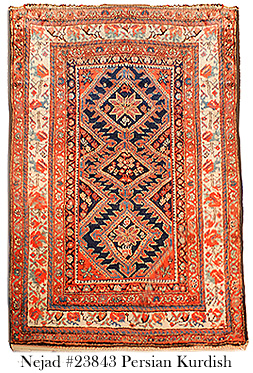About Antique Kurdish Oriental Rugs
Overview
There are at least a few thousand towns and villages in the country of Iran that produce, or that have produced, rugs. And, by definition, any such rug made or produced there - in Iran - would be considered a Persian Rug. Named for the people who produce them, Kurdish rugs are rugs woven by the Kurdish people of Iran. Although rugs made by Kurds could be from any one of a half-dozen countries bordering Iran, the term Kurdish Rug usually refers to, and has become synonymous with, rugs made within Iranian Kurdistan and the province of West Azerbaijan in particular, along Iran's western border.
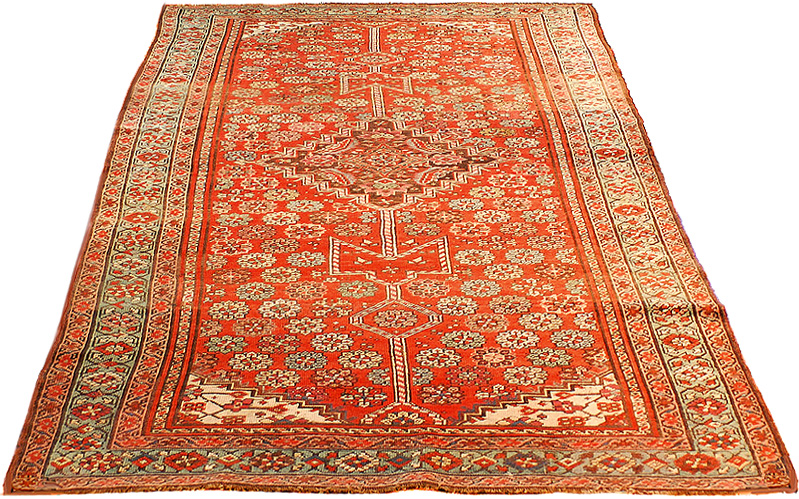
An outstanding example of an antique, large, Caucasian Kurdish woven
carpet currently being offered by Nejad Rugs.
The Antique Kurdish Rug
Even though the antique Kurdish carpet occassionally features a center medallion, the all-over design - including either floral Mina Khani motifs or geometric patterns known as jaff - is far more common. The Kurdish Rug - usually employing a symmetrical knotting upon a woolen foundation can be either stout and solid in structure (i.e. Bidjar) or of a finer more-pliable texture. These heirloom carpets are enhanced by the luminous colors and lustrous wool used - a field of terracotta and burnt orange with greens, blues and ochres may additionally feature traditional Kurdish symbols as a programmatic element literally embedded into the fabric.
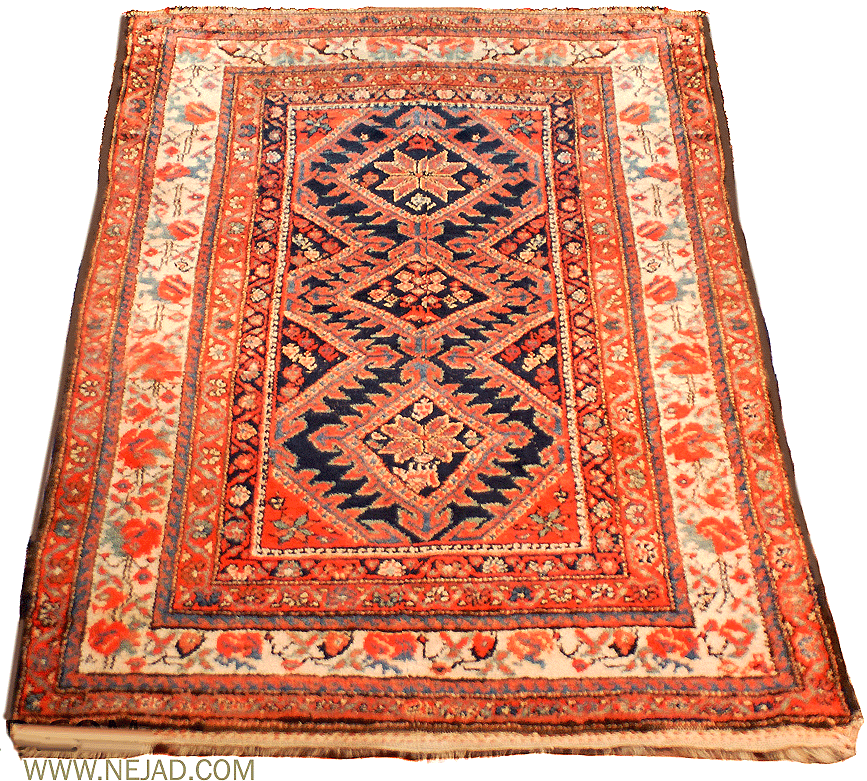
An investment-quality genuine antique Persian Kurdish Navy/Ivory
4' 7" × 6' 11" woven carpet currently offered by Nejad Rugs.
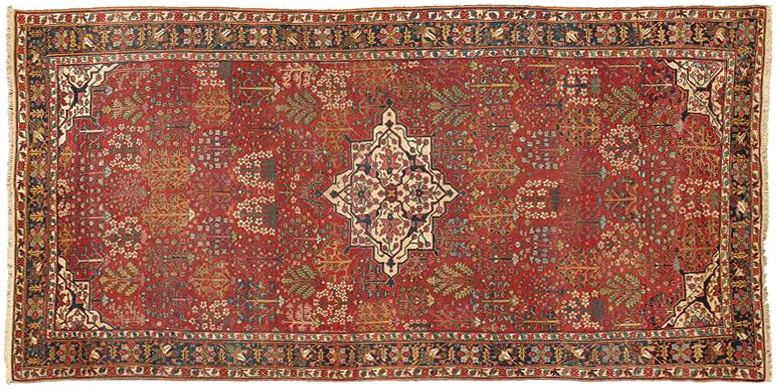
A 10 ft. 3 in. × 7 ft. 11 in. Northwest Persian
Shrub & Medallion late 18th-century carpet - Sotheby's (Notes below):
- The lustrous wool, vivid color and supple handle of this carpet are characteristics shared with 'Proto-Kurdish' weavings from the Soujbulagh area
- The large scale herati design overlaid with a medallion and spandrels is very similar to a carpet formerly in the collection of James Burns
- The border designs of these carpets differ, with the border on the carpet offered here having a flowering vine found in many Persian carpets, for an early example, the Safavid carpet in the Keir Collection
- While the structure of this carpet points to a Northwest Persian origin, the design is also found in carpets woven in the south by the Khamseh and Afshar
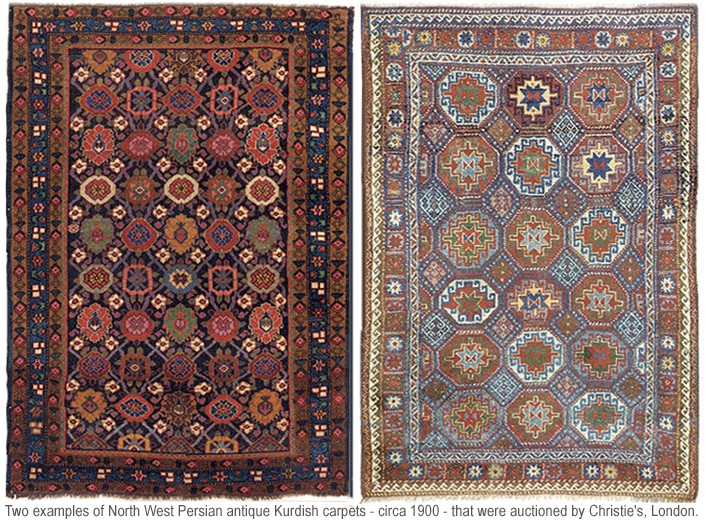
Of the two carpets above, the one on the left features a
Mina Khani pattern while the one on the right a Jaff pattern.
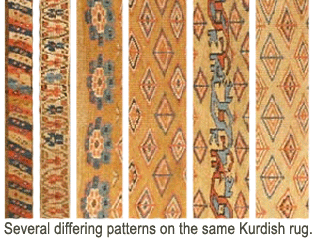

HOLD
MOUSE HERE TO VIEW KURDISH POPULATION AREAS ON MAP
The Kurdish People (The Kurds)
Tracing their origins back a few thousand years, give or take, to the vast territorial expanse
of the northern regions of the Middle East - between the Black and Caspian Seas - that features
wide plains nestled between snow-peaked mountain ranges, the Kurds inhabit a land where, reportedly,
Noah's Ark came to its final resting place - a land that is loosely referred to today as Kurdestan.
More recently, Kurdistan was divided between the Safavid and Ottoman Empires in
the 16th century, and divided further still - being partitioned between Turkey, Iran, Iraq and Syria -
after World War I under the treaty of Laussane. Today the Kurdish
people, a "stateless" nation of some 40 million, inhabit a region which happens to fall under the
politial jurisdiction, collectively, of the nations of Iran, Iraq, Turkey, Armenia, Azerbaijan
and Syria, and, as such, possess no viable basis for recognition (of Kurdistan) as a sovereign entity.
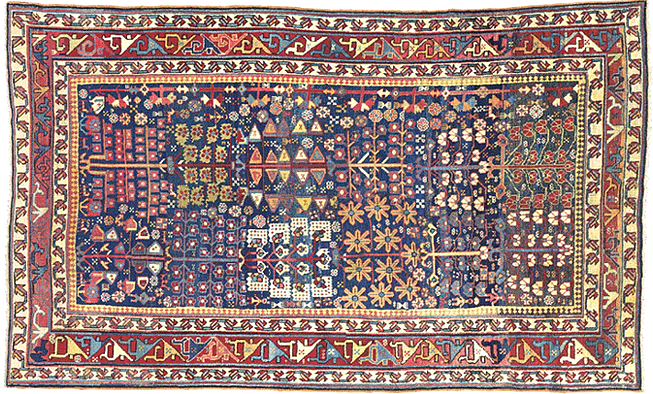
A 9' 3" × 5' 6" One-of-A-Kind Kurdish early 19th Century
Rug (South Caucasus) - Christie's London.
Consumer Notes
The quality of the rugs produced by the Kurish tribes of Persian Kurdistan differs from those made by the Kurdish tribes just over the border - namely in Iraq and Turkey. Ecclectic, showing the Persian influence in both design and quality, the Persian Kurdish rug is a finer, more closely-knit, less tribal-looking rug - the carpet pile trimmed almost to the closeness of a classic Persian rug. Additionally, the geographic position within Iran itself is another factor: in the north, the rugs may incorporate the large geometrical figures in the central field often seen in the Karabagh style, while moving south, toward Kermanshah, the rugs may feature an arboreal design with flowering shrubs arranged in rows - more typical of the Senneh style.
Currently Nejad is offering the following antique Kurdish carpets for sale: #23843 Kurdish | #24314 Kurdish
About:
Tabriz Antique Rugs | Heriz Antique Rugs | Mashhad Antique Rugs | Sarouk Antique Rugs | Kashan Antique Rugs
Kerman Antique Rugs | Serapi Antique Rugs | Bidjar Antique Rugs | Karabagh Antique Rugs | Senneh Antique Rugs
Bakhtiari & Antique Bakhtiari Rugs | Nain and Antique Nain Persian Rugs | Ziegler Mahal Antique Persian Rugs
Esfahan & Antique Esfahan Rugs | Qum Antique Rugs | Farahan Antique Rugs | Darjazin-Hamadan Antique Rugs
Hereke Antique Rugs | Akstafa Antique Rugs | Antique Gharajeh Rugs | Chichi Antique Rugs | Mudjar Antique Rugs
Kazak Antique Rugs | Shirvan Antique Rugs | Beluch Antique Rugs | Peking Antique Rugs | Kurdish Antique Rugs
Turkeman Antique Rugs | Dagestan Antique Rugs | Flemish Antique Tapestry | Antique Ming Chinese Rugs
French Aubusson Antique Tapestry
- after Francois Boucher
